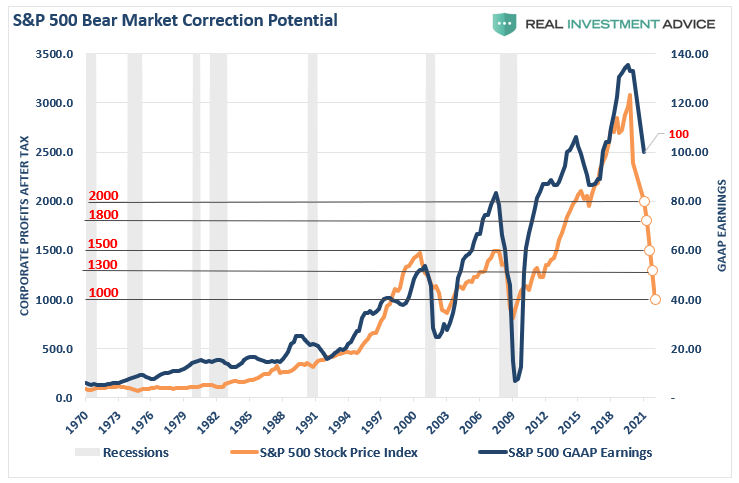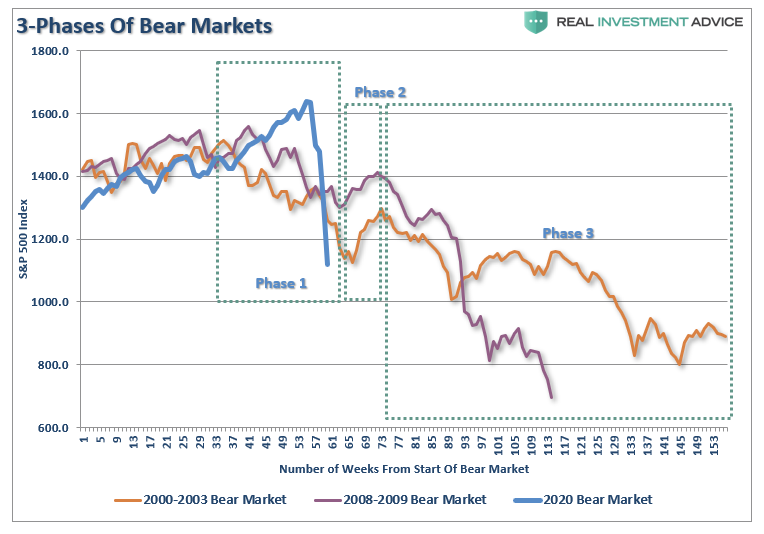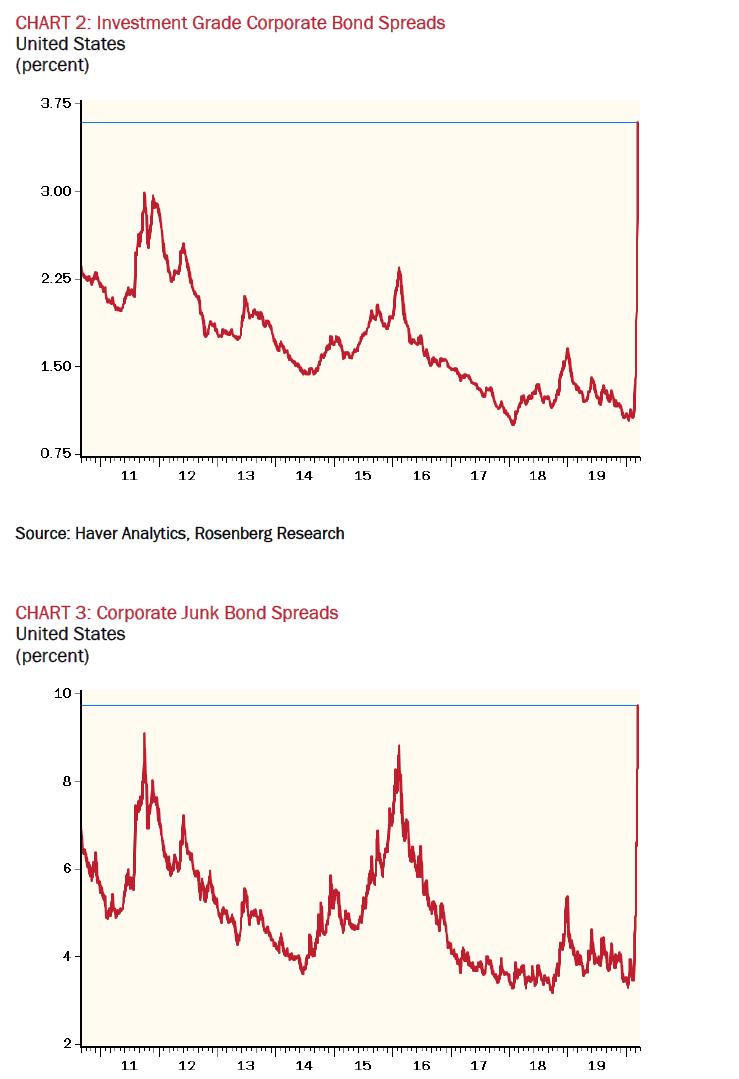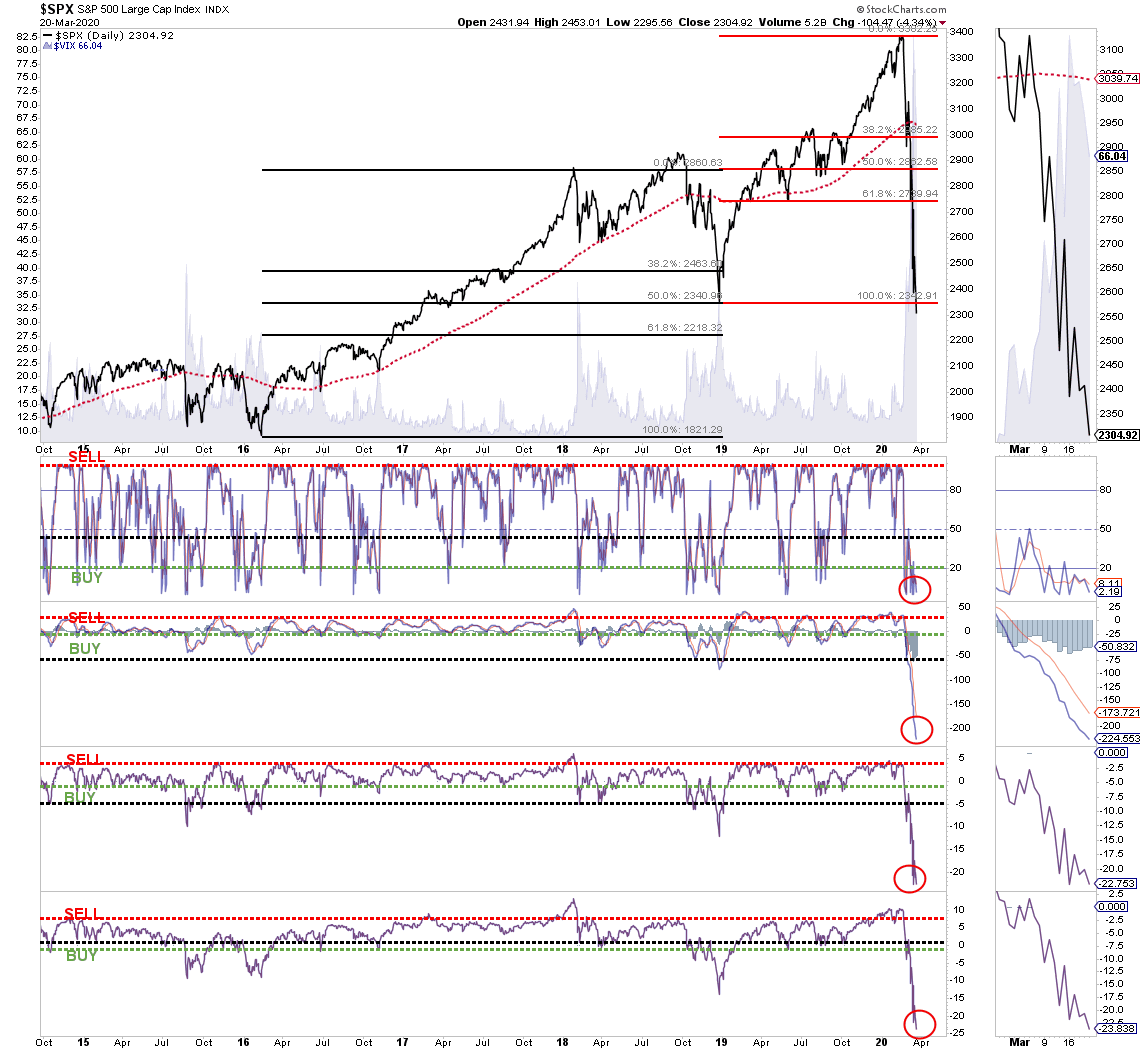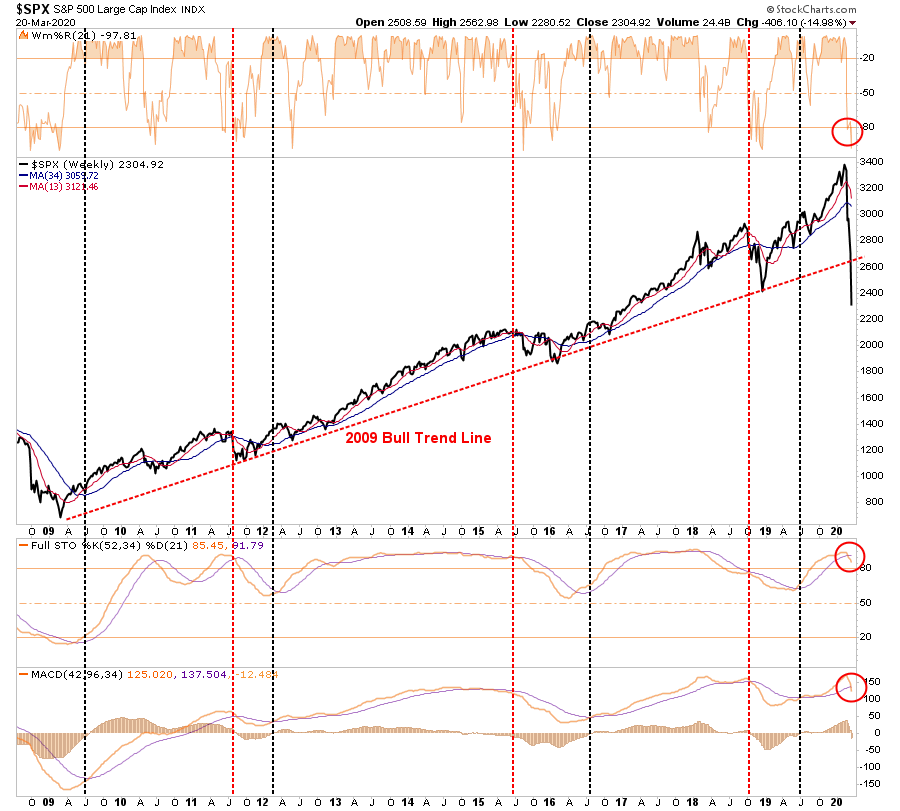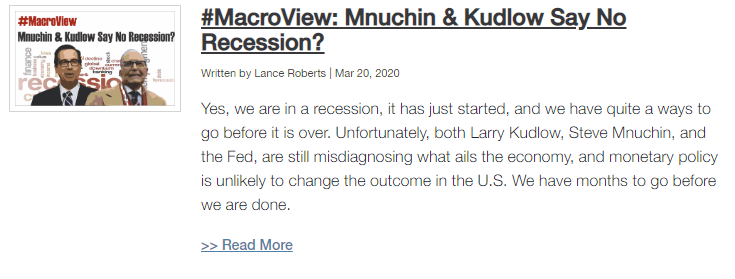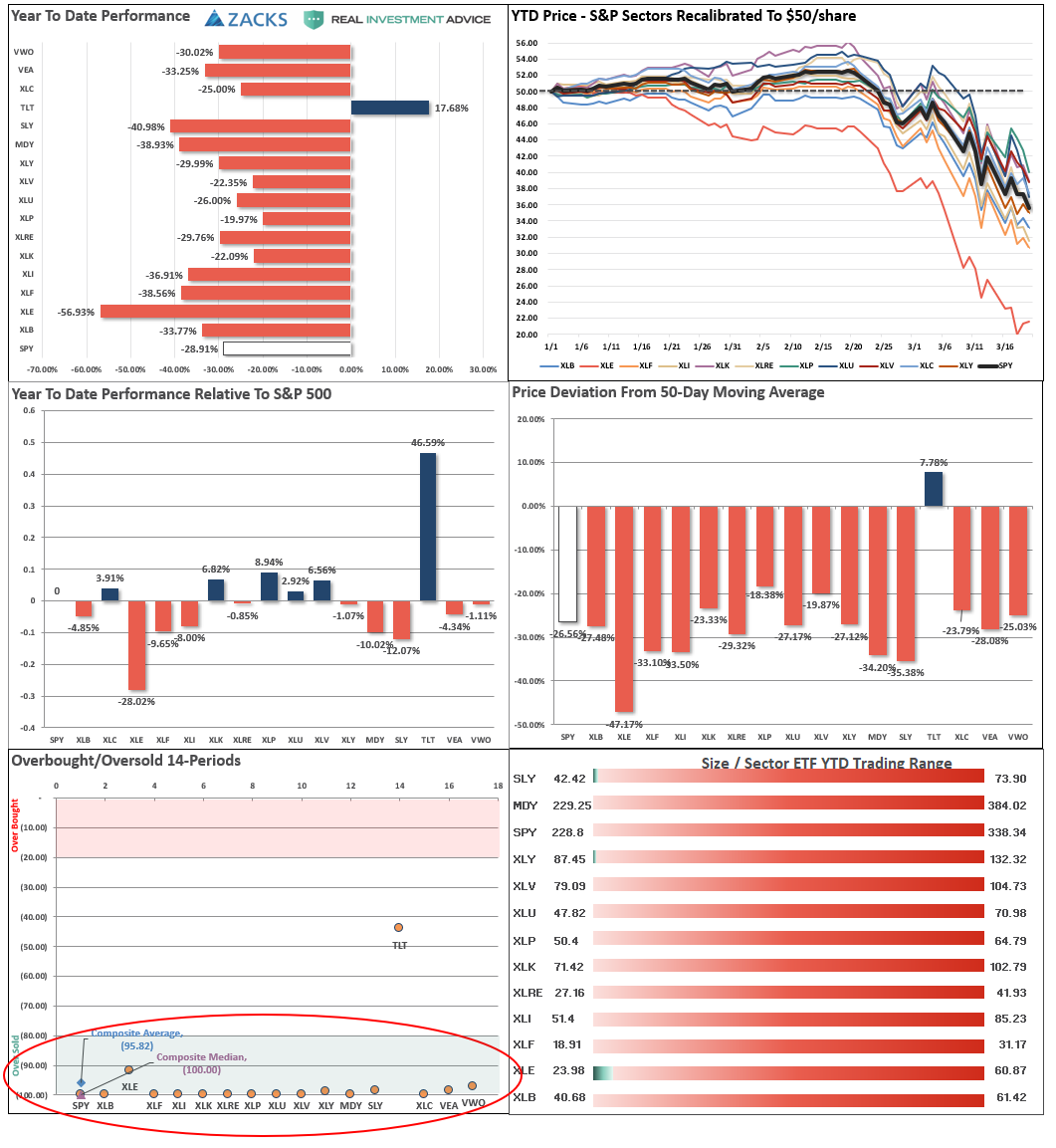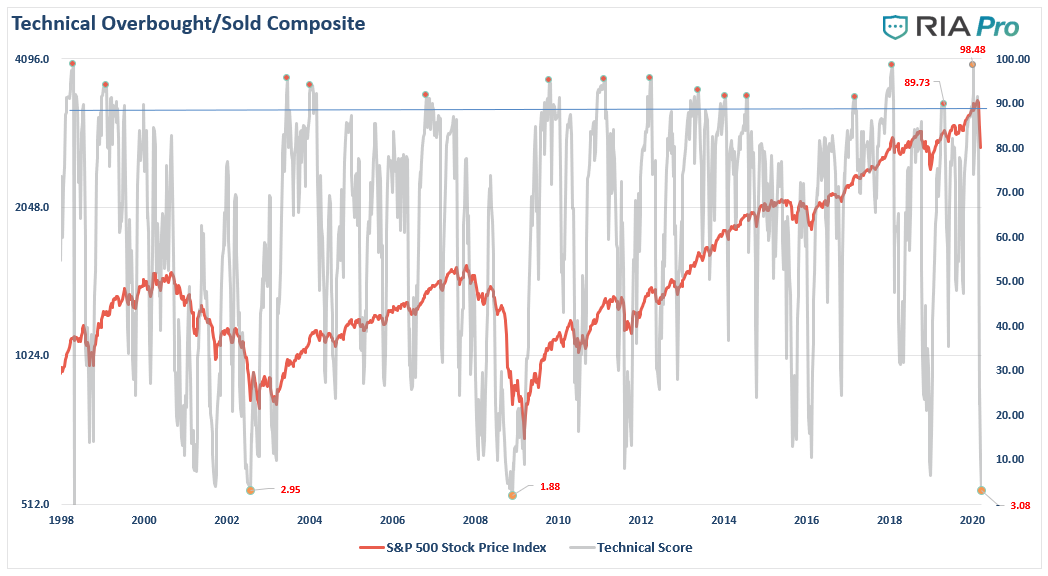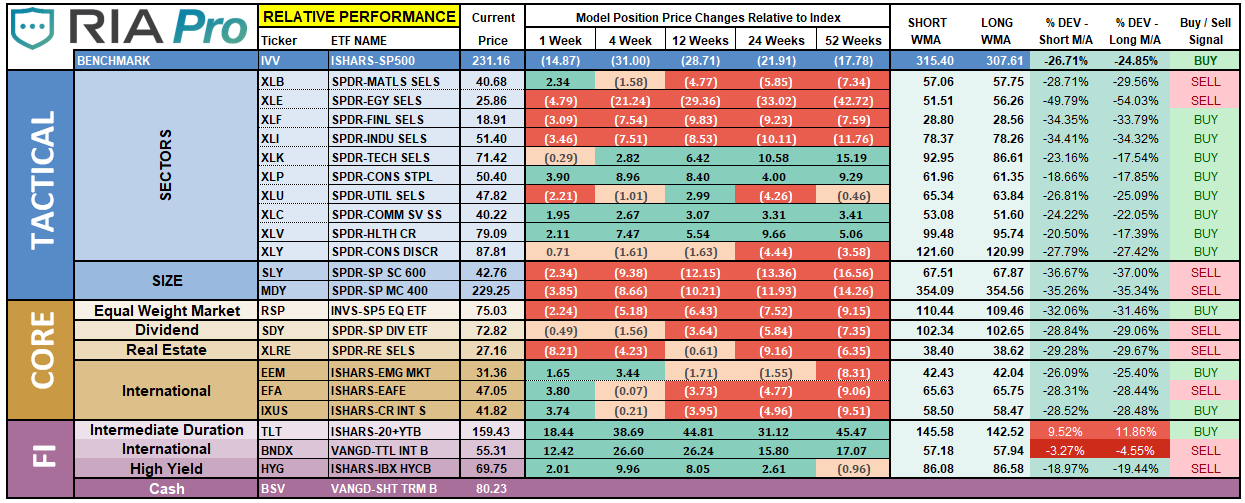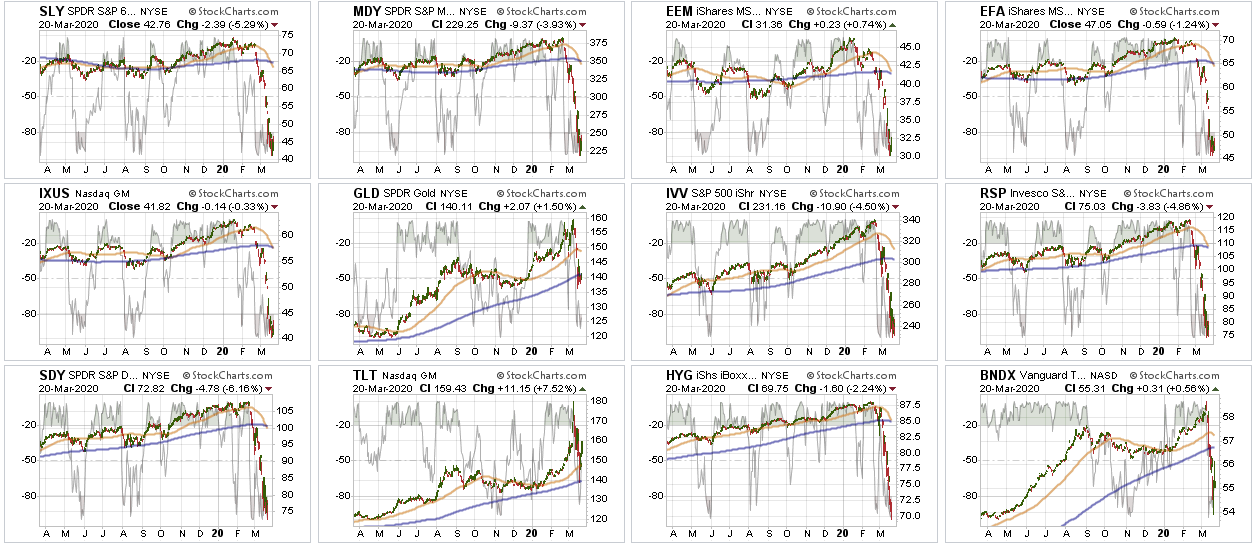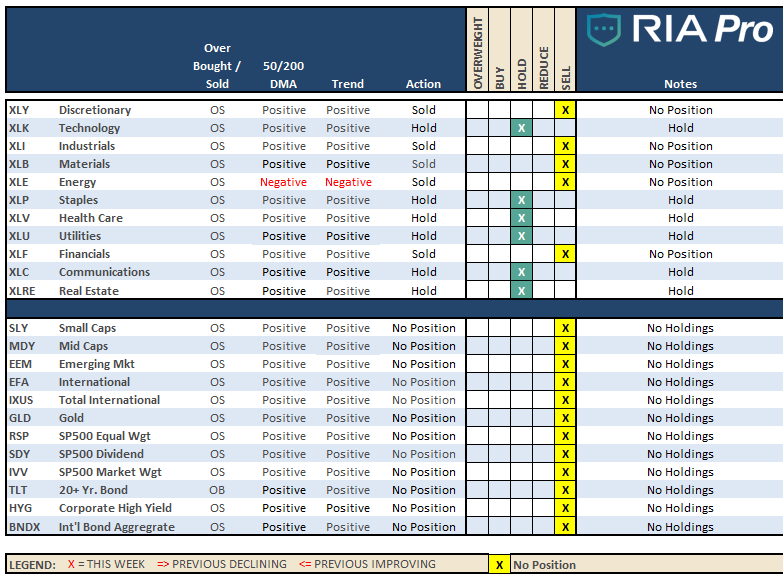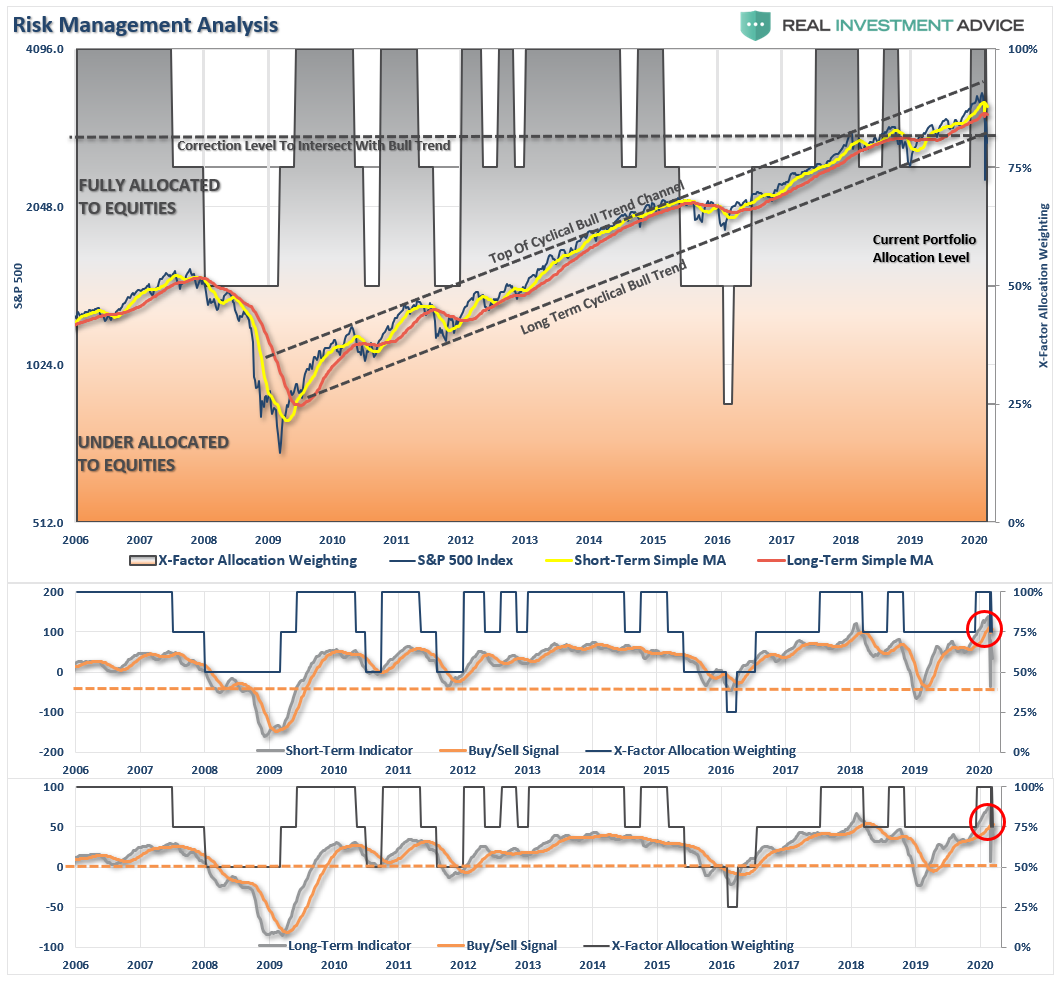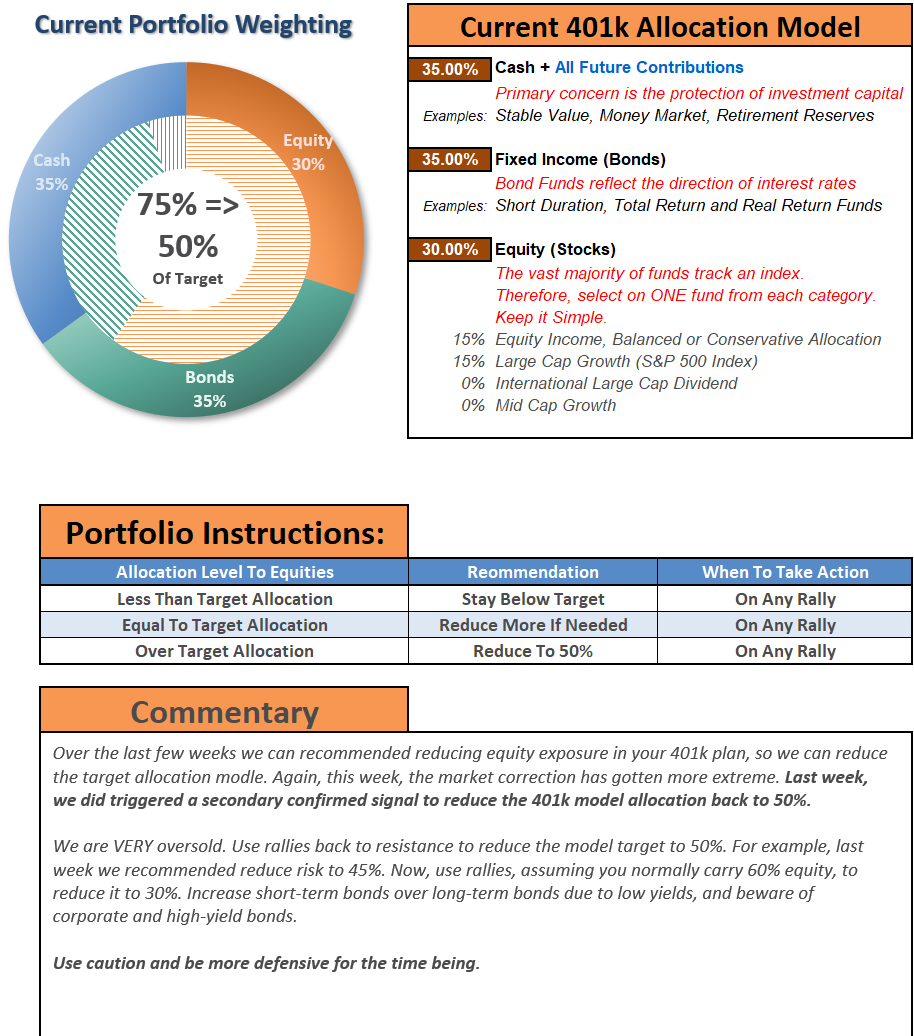Everyone Wanting To Buy Suggests The Bear Still Prowls (Full Report)

- Everyone Wanting To Buy Suggests The Bear Still Prowls
- MacroView: Mnuchin & Kudlow Say No Recession?
- Sector & Market Analysis
- 401k Plan Manager
Follow Us On: Twitter, Facebook, Linked-In, Sound Cloud, Seeking Alpha
Catch Up On What You Missed Last Week
NOTE: During these tumultuous times, we are unlocking our full newsletter to help you navigate the markets safely. Make sure you subscribe to RIAPRO.NET (Free 30-Day Trial) if you want to keep receiving the full report after the storm passes.
Everyone Wanting To Buy Suggests The Bear Still Prowls
“If you own 10% equities, as we do, and the market falls 100%, you will lose 10%. That said, you have 90 cents on the dollar to buy equities for free.” – Michael Lebowitz
Let me explain his comment.
Last week, we wrote a piece titled: Risk Limits Hit. When Too Little Is Too Much in which we discussed reducing our equity risk to our lowest levels.
For the last several months, we have been issuing repeated warnings about the market. While such comments are often mistaken for “being bearish,” we have often stated it is our process of managing “risk,” which is most important.
Beginning in mid-January, we began taking profits out of our portfolios and reducing risk. To wit:
‘On Friday, we began the orderly process of reducing exposure in our portfolios to take in profits, reduce portfolio risk, and raise cash levels.’
Importantly, we did not ‘sell everything’ and go to cash.
Since then, we took profits and rebalanced risk again in late January and early February as well.
On Friday/Monday, our ‘limits’ were breached, which required us to sell more.”
There are a couple of important things to understand about our current equity exposure.
To begin with, we never go to 100% cash. The reason is that “psychologically” it is too difficult for clients to start “buying” when the market finally bottoms. Seeing the market begin to recover, along with their portfolio, makes it easier to fight the fear the market is “going to zero.”
Secondly, and most importantly, at just 10% in current equity exposure, the market could literally fall 100% and our portfolios would only decline by 10%. (Of course, given we still have 90% of our capital left, we can buy a tremendous amount of “free assets.”)
Of course, the market isn’t going to zero.
However, let’s map out a more realistic example.
In this week’s MacroView, we discussed the “valuation” issue
“If our, and Mr. Rosenberg’s, estimates are correct of a 5-8% recessionary drag in the second quarter of 2020, then an average reduction in earnings of 30% is most likely overly optimistic.
However, here is the math:
- Current Earnings = 132.90
- 30% Reduction = $100 (rounding down for easier math)
At various P/E multiples, we can predict where “fair value” for the market is based on historical assumptions:
- 20x earnings: Historically high but markets have traded at high valuations for the last decade.
- 18x earnings: Still historically high.
- 15x earnings: Long-Term Average
- 13x earnings: Undervalued
- 10x earnings: Extremely undervalued but aligned with secular bear market bottoms.
You can pick your own level where you think P/E’s will account for the global recession but the chart below prices it into the market.”
So, let’s assume our numbers are optimistically in the “ballpark” of a valuation reversion, and earnings are only cut by 30% while the market bottoms at 1800, or 18x earnings. (I say optimistically because normal valuation reversions are 15x earnings or less.)
Here’s the math:
- For a “buy and hold” investor (who is already down 20-30% from the peak) will lose an additional 22%.
- For a client with 10% equity exposure, they will lose an additional 2.2%.
When the market does eventually bottom, and it will, it will be far easier for our clients to recover 10% of their portfolio versus 50% for most “buy and hold” strategies.
As we have often stated, “getting back to even is not an investment strategy.”
Is The Bear Market Over?
This is THE QUESTION for investors. Here are a few articles from the past couple of days:
- Here’s A Few Reasons It Might Be A Good Time To Buy – Motley Fool
- Time To Start Bottom Fishing – RBC
- 6-Signals Say A Bottom Is In – CNBC
And then you have clueless economists, like Brian Wesbury from First Trust, who have never seen a “bear market,” or “recession,” until it’s over.
March 6th.
Why is this important? Because “bear markets don’t bottom with optimism, they end with despair.”
As I wrote last week:
“Bob Farrell, a legendary investor, is famous for his 10-Investment Rules to follow.
Bear markets have three stages – sharp down, reflexive rebound and a drawn-out fundamental downtrend – Rule #8
- Bear markets often START with a sharp and swift decline.
- After this decline, there is an oversold bounce that retraces a portion of that decline.
- The longer-term decline then continues, at a slower and more grinding pace, as the fundamentals deteriorate.
Dow Theory also suggests that bear markets consist of three down legs with reflexive rebounds in between.
The chart above shows the stages of the last two primary cyclical bear markets versus today (the 2020 scale has been adjusted to match.)
The answer to the question is simply this:
“When is it time to start buying the market? When you do NOT want to.”

Bond Market Implosion
At the moment, the Federal Reserve is fighting a potentially losing battle – the bond market.
- After cutting rates to zero and launching QE of $700 billion – the markets crashed.
- The ECB starts an $800 billion QE program, and the markets fail to move.
- The Fed injected liquidity into money markets, the credit market, and is buying municipal bonds.
- And the market crashed more.
The Fed has literally turned on a “garden hose” to extinguish a literal “bon(d)fire.”
This was no more evident than their action this past week to revive a program from the financial crisis called the Primary Dealer Credit Facility (PDCF) to bailout hedge funds and banks. Via Mike Witney:
“The Fed is reopening its most controversial and despised crisis-era bailout facility, the Primary Dealer Credit Facility. The facility’s real purpose is to transfer the toxic bonds and securities from failing financial institutions and corporations (through an intermediary) onto the Fed’s balance sheet.
The objective of this sleight of hand is to recapitalize big investors who, through their own bad bets, are now either underwater or in deep trouble. Just like 2008, the Fed is now doing everything in its power to save its friends and mop up the ocean of red ink that was generated during the 10-year orgy of speculation that has ended in crashing markets and a wave of deflation. Check out this excerpt from an article at Wall Street on Parade. Here’s an excerpt:
“Veterans on Wall Street think of the PDCF as the cash-for-trash facility, where Wall Street’s toxic waste from a decade of irresponsible trading and lending, will be purged from the balance sheets of the Wall Street firms and handed over to the balance sheet of the Federal Reserve – just as it was during the last financial crisis on Wall Street.”
– (“Fed Announces Program for Wall Street Banks to Pledge Plunging Stocks to Get Trillions in Loans at ¼ Percent Interest” Wall Street on Parade)
In other words, the PDCF is a landfill for distressed assets that have lost much of their value and for which there is little or no demand. And, as bad as that sounds, the details about the resuscitated PDCF are much worse.”
If you have any doubt how bad it is in the bond market, just take a look at what happened to both investment grade and junk bond spreads. (Charts courtesy of David Rosenberg)
As they say: “That clearly ain’t normal.”
More importantly, the “Bear Market” won’t be over until the credit markets get fixed.
Hunting The Bear
It was a pretty stunning week in the market. Over the last 5-days, the market declined an astonishing, or should I say breathtaking, 15%. The last time we saw a one week decline of that magnitude was during the “Lehman” crisis. (Of course, with hedge funds blowing up all week, this is precisely what the Fed has been bailing out.)
Since the peak of the market at the end of February, the market is now down a whopping 32%.
Surely, we are close to a bottom?
Let’s revisit our daily and weekly charts for some clues as to where we are, what could happen next, and what actions to take.
On a daily basis, the market is extremely stretched and deviated to the downside. Friday’s selloff smacked of an “Oriental Rug Company” where it was an “Everything Must Go Liquidation Event.”
Remember all those headlines from early this year:
Well….
This selloff completely reversed the entire advance from the 2018 lows. That’s the bad news.
The good news is the markets are now more extremely oversold on a variety of measures than at just about any other point in history.
Such a reversal, particularly given the “speed and magnitude” of the decline, argues for a “reversal” of some sort.
Warning: Any reversal will NOT BE the bear market bottom. It will be a “bear market” rally you will want to “sell” into. The reason is there are still many investors trapped in “buy and hold” and “passive indexing” strategies which are actively seeking an exit. Any rallies will be met with redemptions.
As noted above, bear markets do not end with investors wanting to “buy” the market. They end when “everyone wants to sell.”
And, NO, investors are “not different this time.”
This “bear market” rally scenario becomes more evident when we view our longer-term weekly “sell signals.” As we warned last week:
“With all of our signals now triggered from fairly high levels, it suggests the current selloff is not over as of yet. In other words, we will see a rally, followed by a secondary failure to lower lows, before the ultimate bottom is put in.”
Unfortunately, we have yet to see any attempt at a sustained rally.
More importantly, with the failure of the markets to hold lows this week, both of our long-term weekly “sell signals” have now been triggered. Such would suggest that a rally back to the “bullish trend line” from 2009 will likely be the best opportunity to “sell” before the “bear market” finds its final low.
Where will that low likely be:
Let’s update our mapping from last week:
- A retest of current lows that holds is a 27% decline. – Failed
- A retest of the 2018 lows, which is most likely, an average recessionary decline of 32.8% – Current
- A retest of the 2016 lows, coincident with a “credit event,” would entail a 50.9% decline. – Pending Possibility.
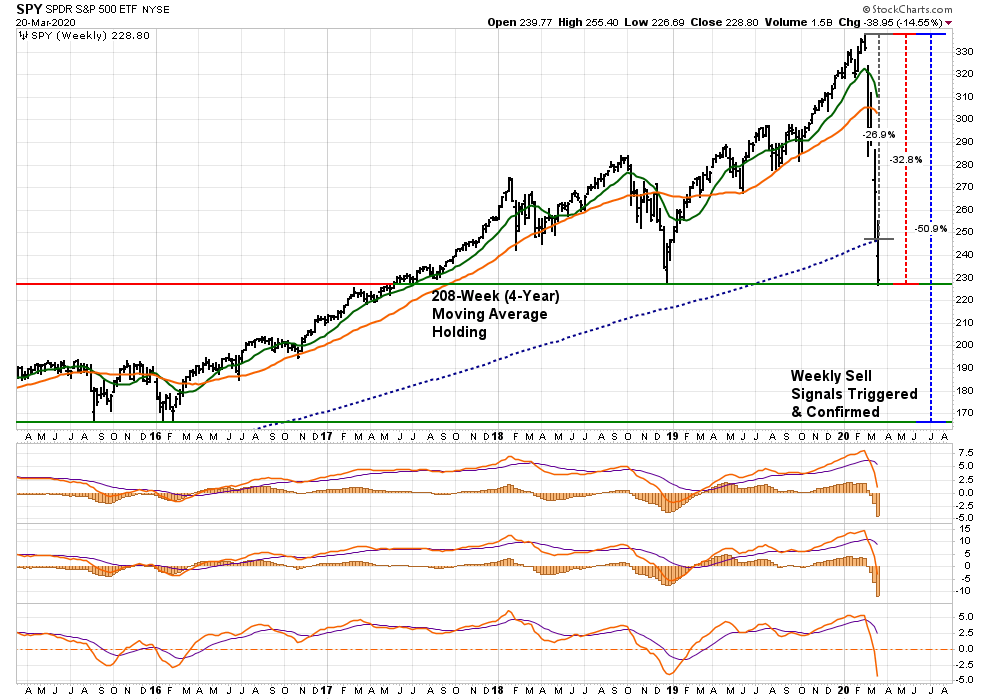
Given the magnitude, and multiple confirmations, of these signals, it is far too soon to assume the “bear market” is over. This is particularly the case, given the selloff is less than one-month old.
Bear markets, and recessions, tend to last 18-months on average.
The current bear market and recession are not the result of just the “coronavirus” shock. It is the result of many simultaneous shocks from:
- Economic disruption
- Surging unemployment
- Oil price shock
- Collapsing consumer confidence, and
- A “credit event.”
We likely have more to go before we can safely assume we have turned the corner.
In the meantime, use rallies to raise cash. Don’t worry about trying to “buy the bottom.” There will be plenty of time to see “THE” bottom is in, and having cash will allow you to “buy stocks” from the last of the “weak hands.”

The MacroView
If you need help or have questions, we are always glad to help. Just email me.
See You Next Week
By Lance Roberts, CIO
Market & Sector Analysis
Data Analysis Of The Market & Sectors For Traders
S&P 500 Tear Sheet
Performance Analysis
Technical Composite
Note: The technical gauge is now at the lowest level since both the “Dot.com” and “Financial Crisis.” However, note the gauge bottoms BEFORE the market bottoms. In 2002, lows were retested. In 2008, there was an additional 22% decline into early 2009.
ETF Model Relative Performance Analysis
Sector & Market Analysis:
Be sure and catch our updates on Major Markets (Monday) and Major Sectors (Tuesday) with updated buy/stop/sell levels
Sector-by-Sector
For the 3rd week in a row:
“Everything was crushed again this past week, so the difference between leading and lagging sectors is which sector fell faster or slower than the S&P 500 index itself.”
Improving – Discretionary (XLY), and Real Estate (XLRE)
We previously reduced our weightings to Real Estate and liquidated Discretionary entirely over concerns of the virus and impact to the economy. No change this week.
Current Positions: 1.2 weight XLRE
Outperforming – Technology (XLK), Communications (XLC), Staples (XLP), Healthcare (XLV), and Utilities (XLU)
The correction in Technology last week broke support at the 200-dma but finished the week very close to the May 2019 lows. Communication and Utilities didn’t perform as well but also held up better during the decline on a relative basis. The same is true for Utilities and Staples. These are our core ETF’s right now at which we are carrying substantially reduced exposure.
Current Positions: 1/2 weight XLK, XLC, XLU, XLP, XLV
Weakening – None
No sectors in this quadrant.
Current Position: None
Lagging – Industrials (XLI), Financials (XLF), Materials (XLB), and Energy (XLE)
No change from last week, with the exception that performance continued to be worse than the overall market.
These sectors are THE most sensitive to Fed actions (XLF) and the shutdown of the economy. We eliminated all holdings in late February and early March.
Current Position: None
Market By Market
Small-Cap (SLY) and Mid Cap (MDY) – Three weeks ago, we sold all small-cap and mid-cap exposure over concerns of the impact of the coronavirus. Remain out of these sectors for now.
Current Position: None
Emerging, International (EEM) & Total International Markets (EFA)
Same as small-cap and mid-cap. Given the spread of the virus and the impact on the global supply chain. Trading opportunities only.
Current Position: None
S&P 500 Index (Core Holding) – Given the rapid deterioration of the broad market, we sold our entire core position holdings for the safety of cash.
Current Position: None
Gold (GLD) – Gold broke our stop, and we sold our holdings. We are now on the watch for an entry point if Gold can climb back above the 200-dma.
Current Position: None
Bonds (TLT) –
Bonds collapsed last week as the “credit event” we have been concerned about took shape. We had previously taken profits and reduced our bond holdings duration and increased credit quality. We have now reduced our total bond exposure to 20% of the portfolio from 40% since we are only carrying 10% equity currently. (Rebalanced our hedge.)
Current Positions: SHY, IEF, BIL
Sector / Market Recommendations
The table below shows thoughts on specific actions related to the current market environment.
(These are not recommendations or solicitations to take any action. This is for informational purposes only related to market extremes and contrarian positioning within portfolios. Use at your own risk and peril.)
Portfolio/Client Update:
I know it is ugly.
The S&P 500 is down nearly 32% in just three weeks.
That’s scary.
However, it is important to keep some perspective on where we are currently.
Last Monday, we further reduced our equity to just 10% (from 25% previously) of the portfolio
What does that mean? Here is some math:
If the market goes to ZERO from here, (it’s not going to) your MAXIMUM loss is just 10%.
This is recoverable, particularly if we could buy a portfolio of assets for FREE.
We currently expect a maximum decline from current levels of 20%. This would be a 2% net hit to portfolios leaving us with a LOT of cash to buy distressed assets at 50% off.
This is the opportunity we have been waiting for during the entire last decade.
Currently, we are busy rebuilding all of our portfolio models, rethinking risk management in a post-bear market environment, and what role the future of “fixed income” will play in asset allocations.
These are all essential questions that we need solid answers for.
We are in an excellent position with plenty of cash, reduced bond holdings, and minimal equity exposure in companies we want to own for the next 10-years. We are just patiently waiting to buy large chunks of these holdings soon with both stable and higher yields.
Let me assure you of four things;
- The ONLY people who care more about your money than you, is all of us at RIA Advisors.
- We will NOT “buy the bottom” of the market. We will buy when we SEE the bottom of the market is in and risk/reward ratios are clearly in our favor.
- This has been THE fastest bear market in history. We are doing our best to preserve your capital so that you meet your financial goals. Bear markets are never fun, but they are necessary for future gains.
- We’ve got this.
Please don’t hesitate to contact us if you have any questions, or concerns.
Lance Roberts
CIO
THE REAL 401k PLAN MANAGER
A Conservative Strategy For Long-Term Investors
Model performance is based on a two-asset model of stocks and bonds relative to the weighting changes made each week in the newsletter. This is strictly for informational and educational purposes only and should not be relied upon for any reason. Past performance is not a guarantee of future results. Use at your own risk and peril.
401k Plan Manager Live Model
As an RIA PRO subscriber (You get your first 30-days free) you have access to our live 401k p
The code will give you access to the entire site during the 401k-BETA testing process, so not only will you get to help us work out the bugs on the 401k plan manager, you can submit your comments about the rest of the site as well.
We are building models specific to company plans. So, if you would like to see your company plan included specifically, send me the following:
- Name of the company
- Plan Sponsor
- A print out of your plan choices. (Fund Symbol and Fund Name)
If you would like to offer our service to your employees at a deeply discounted corporate rate, please contact me.








